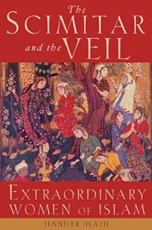"Islam is monotheistic, but it is not a monoculture," notes Jennifer Heath, an award-winning author and journalist, the daughter of an American diplomat who grew up in Latin America and Afghanistan. Thanks to the outrageously slanted reporting in some Western publications, Muslim women are typically seen as "pitiable, shrouded creatures, the essence of oppression, the oblique Other. Women with no history, no self-determination, women who are merely ghosts awaiting resurrection into flesh by the superior forces of the West."
In this rousing and wide-ranging volume, Heath presents profiles and vignettes of 50 Muslim women from the birth of Islam in the seventh century through the nineteenth century. It is said in this tradition that two-thirds of the religion of Islam was handed down by women and one-third was shaped by women. Based on sources ranging from Swahili lore to Persian passion plays, Muslim feminist writings, and modern day assessments by scholars of Islam, the book is divided into the following categories: women of the Prophetate: scholars of the Hadith; ascetics, saints, and mystics; warriors and amazons; rebels and concubines; musicians and dancers; rulers, regents, queen mothers, and philanthropists; tradeswomen and learned ladies; and poets.
"Of worldy things," the Prophet Muhammad said, "women and fragrance are made dear to me and the comfort of my eyes is made in prayer." He was born to a widowed mother, tended by a slave woman, and fostered by a Bedouin woman. Throughout his life, he was nurtured, supported, and advised by his wives and daughters. Heath puts it even more succinctly: "It is no exaggeration to say that the community of Muslims worldwide originated with women." Some of these are profiled here including Barakah, Khadija bint Khuwaylid, Asmaa bint Abu Bakr, Hind bint Utba, Fatima bint Muhammad. and Aisha bint Abu Bakr.
Our favorite chapter is the one on Rabi'a al-Adawiyya, one of the most famous of Islamic saints, known for her devotion to Allah and her ascetic rigor. Everything in her life was related to this surrender. She once noted: "I have never had a knife in my house for fear of cutting myself off, separating myself from God." Her tomb is near the Christian Church of the Ascension in Jerusalem. Heath concludes: 'No day passes without a visitor. They say that Rabi'a was veiled with the veil of sincerity, inflamed by love and yearning, lost in union with God." We also enjoyed the chapter on musicians and dancers where we learned that Arab singing women were sometimes called "grasshoppers" because this insect was associated with the life-restorative values of rain. The many women covered in this volume reveal Islamic paths of devotion, service, creativity, nurturing, mysticism, and wisdom. Hats off to Heath for this ambitious and much-needed work.
